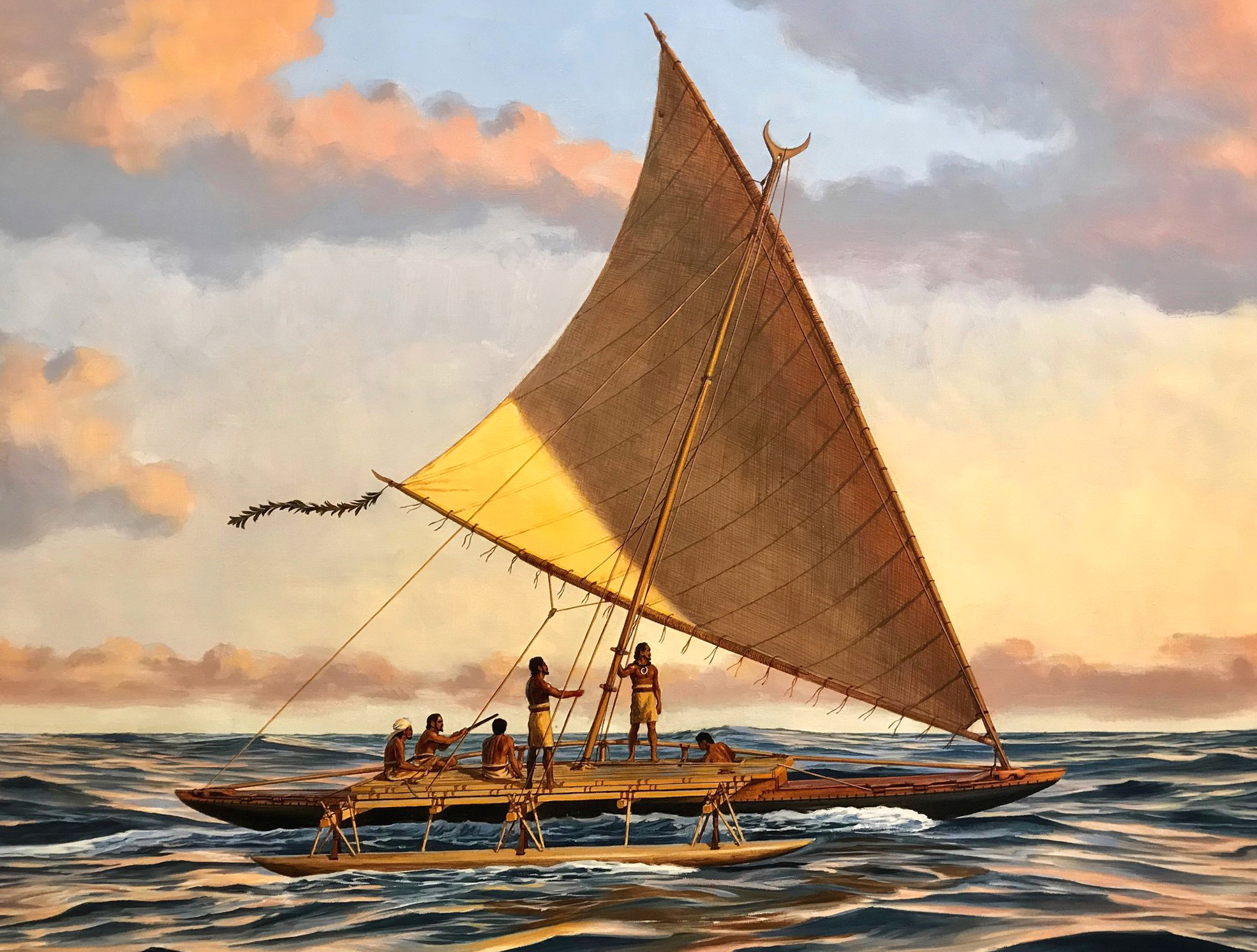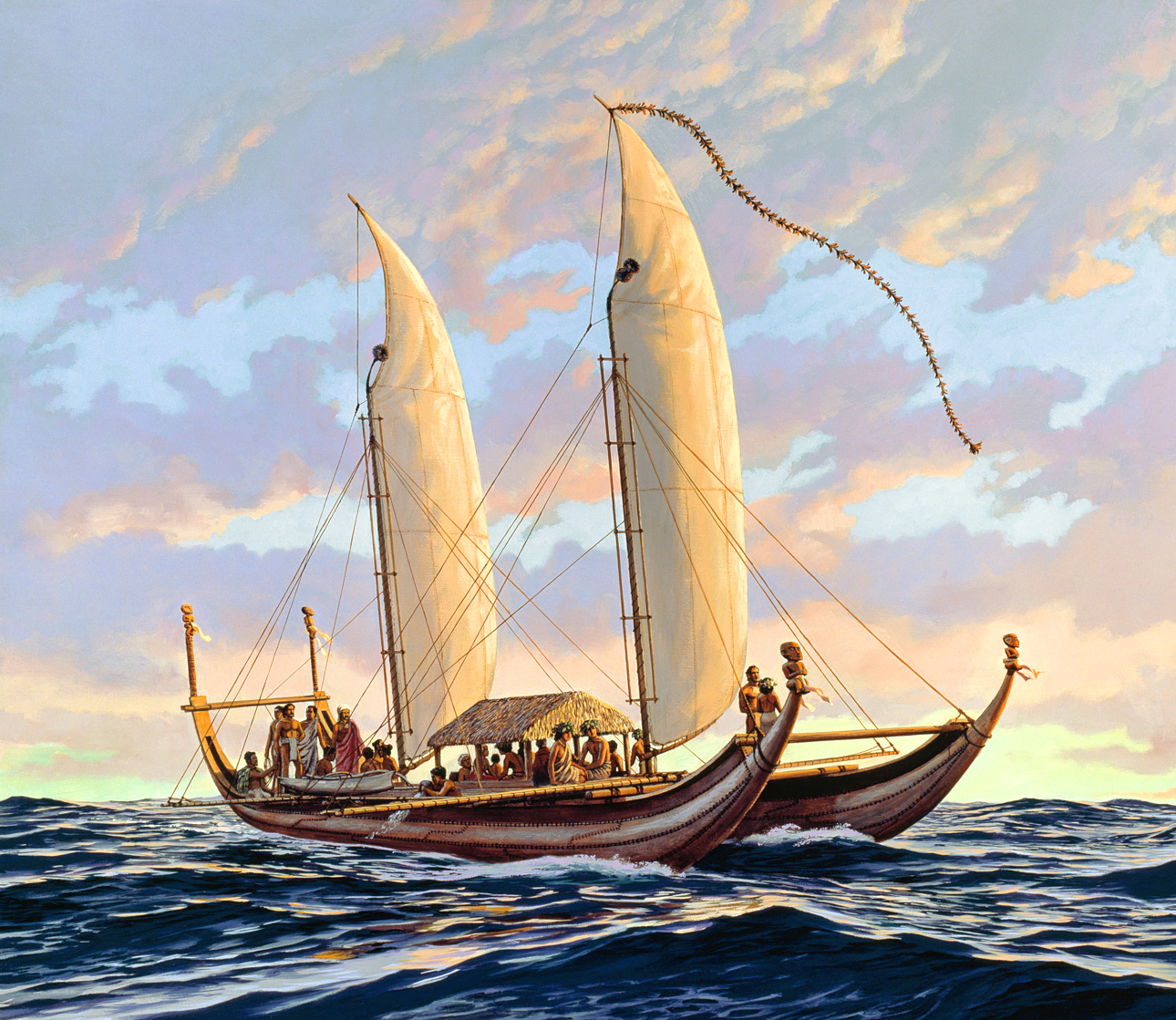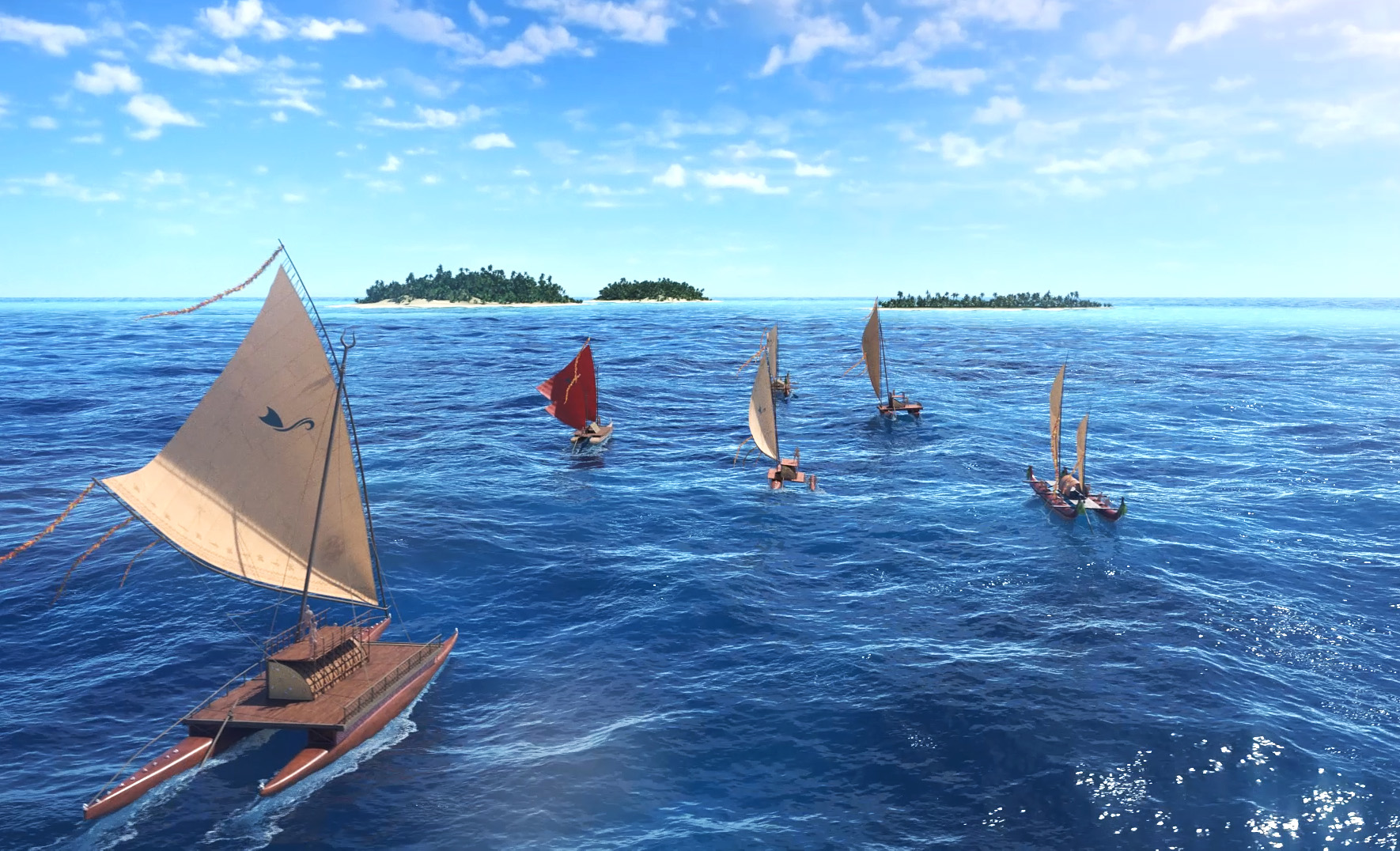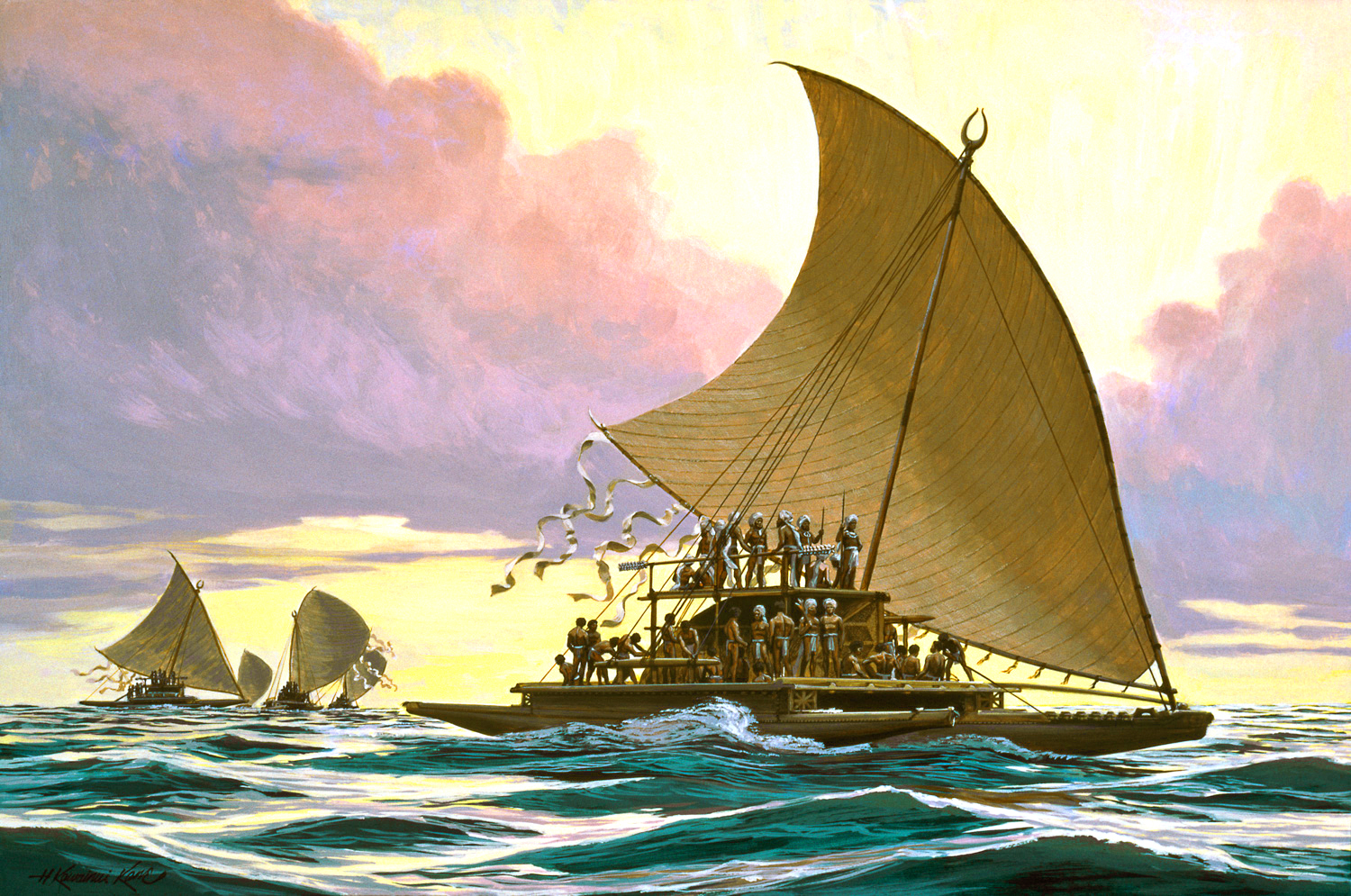MOANA NUI’S VAKA :
EXPLORERS OF THE EARLY AGES
From 70,000 BC to 1200 AD, sailing peoples from Asia undertook one of the most fabulous of human adventures: the conquest of the Pacific Ocean.
In several waves, following the variations in ocean levels, they settled in the heart of present-day Papua and Australia.
A few millennia later, they set out to conquer the open ocean, always heading further east, as far as present-day French Polynesia, Hawaii… and even to the American continent !
Video: Human migrations in ancient Pacific.
Their incredible ability to live and navigate in symbiosis with their environment – through observation of stars, winds, currents, marine and bird life – will go hand in hand with tremendous technological leaps in architecture and shipbuilding.

A Hama Tafua from the Tongan Islands, specially designed to locate new inhabitable lands (painting by Herb Kauai Nui Kane)
.
EFFICIENT, INNOVATIVE AND SUSTAINABLE PREHISTORIC BOATS
Bamboo rafts of the first expeditions gave way to small canoes equipped with an outrigger, which, as the migrations became more and more important, became true prehistoric vessels, ancestors of our modern multihulls.
During their first expeditions, Cook and Bougainville encountered these incredible “VAKA”, as they were called in the Pacific.
They were seduced by their aesthetics, bluffed by their performances, thanks to which these VAKAs were litteraly passing our heavy European three-masts vessels.

The first European explorers, fascinated by these great Oceanian VAKA, made numerous plans and artistic drawings.
THE MOANA NUI PROJECT WILL REVIVE THESE LEGENDARY BOATS
These VAKA will be reborn to relive the conquest of the Pacific, in order to rediscover the traditional knowledges that has enabled the Oceanian and Polynesian peoples to survive despite deep and various crises, by preserving their common asset : the Ocean.
Christophe Mercier – founder of the MOANA NUI project

A Tahitian Pahi, large double hulled Polynesian voyaging canoe.
3D videos with 360° views of the different types of VAKA from the MOANA NUI Project
..
AN ARCHITECTURAL, ECOLOGICAL AND CULTURAL CHALLENGE
Thanks to our partnership with the naval architecture firm VPLP design, a world-renowned expert in the design of racing multihulls, and with the naval designer Jean-Paul Blanc, a specialist in traditional canoe design, everything is in place to revive these ancient multihulls.
The amphidromy, the “crab claw” sails, the mobility of the hulls in relation to each other: all these ingenious specificities of the ancient Polynesian catamarans will constitute an architectural challenge that will be met by MOANA NUI and VPLP.
The search for performance will be at the heart of this challenge, as well as the building processes, which will be as close as possible to ancestral techniques.
The materials used in these VAKAs will be ecological and sustainable: bamboo, traceable wood, bio-composites.

The ancestral VAKA fleet of the MOANA NUI Odyssey.
These VAKA will each represent a specific region of the Pacific, in the purest respect of the richness of the traditions and cultures of the Great Ocean, to which MOANA NUI intends to pay tribute:
. A Pahi from Tahiti, a 28-metre double crab claw pirogue (1): this large and majestic pirogue is emblematic of the great migratory journeys in the heart of the Polynesian triangle.
. A Kalia from Tonga, a double pirogue, with one hull smaller than the other, amphidrome, 24 metres long. A large travel pirogue, contemporary to the Pahi, it was used for long distance travel, trade, but also for war.
. A Va’a Tele from Samoa, a 16.5 metre double monodrome pirogue with a double crab claw, and the particularity of having a bow that is the “ancestor” of our modern bulbs. Quite typical of the “family” pirogues that used to nomadise in this part of the Pacific.
. A Hama Tafua from Tonga, an outrigger pirogue (2) of 16.50 metres, rigged in a “crab claw” style. Quite faithful to what scientists believe to be the ancient Pacific long-distance exploration pirogues. This type of pirogue was used to locate sites/islands that could be inhabited later.
. A Vaka Tou’ua from the Marquesas, a 20 metre double crab claw pirogue, without a mast, using its two sails as a kite attached to the deck. This pirogue had as additional propulsion system the use of rowers, located in the hulls. It was these canoes that discovered Hawaii and inspired a whole new generation of travel canoes.
. A Drua from Fiji: the state of the art in large Pacific travel canoes. Quite similar to the Kalia although with some technical differences. Amphidrome, equipped with a huge crab claw sail of nearly 200 square meters and a tilting mast, the flagship of our fleet, she will measure 30 meters. She was used for long voyages and always belonged to Ari’i, to kings. Trade, migrations or “diplomatic” voyages, she could also be used for war and take on board 200 men in arms, which allowed her, thanks to the additional ballast, to “over-top”, up to 350 square metres, to arrive faster and take her enemies by surprise…

A fleet of Drua from Fiji islands. Some Drua could carry up to 200 passengers.
THE VAKA, AMBASSADORS AND ACTORS OF THE PROTECTION OF THE OCEANS
Historically, these VAKAs, these large “voyaging canoes” were used for exploration, migration, trade, diplomatic travel and sometimes even war!
But they were also and above all used to disseminate throughout the Pacific the good practices of sustainable management of oceanic and island areas, when the great ecological transition became vital.
It is this symbolic role that the MOANA NUI canoes’ fleet intend to play wherever they go, advocating and acting for a better, more united, more sustainable future.
1. Monodrome: a boat that is tacking, turning on its side and has a bow and a stern.
2. Amphidrome: a boat that “changes ends” instead of tacking. The sail(s) are tipped from one side of the boat to the other, with the bow and stern undifferentiated. When the sail is tilted, the boat can set off in the opposite direction. It is always the same side that is “upwind”: the side of the beam (or the smaller hull). This mode of movement is, for example, unique to the Pacific Praos. This type of boat must therefore tack widely, a constraint that is compensated for by great speed on one side.
